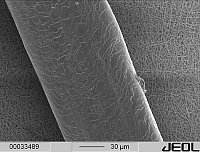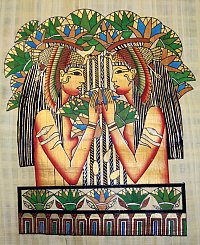Contact
Emeritus Prof. Dr. Goerg Michler
phone: 0345 55 25400
goerg.michler@physik.uni-ha...
Institute of Physics
06099 Halle (Saale)
Egyptian papyri – wound in protective nanofibres
UTE OLBERTZ
Antique textiles and writings and paintings on papyrus are very susceptible to attack by microorganisms, insects and fungi. Scientists at the Martin Luther University are studying how these things can be protected with the aid of electrospun nanofibres as part of a joint German-Egyptian project. The underlying idea was to incorporate antimicrobial active particles into the polymer fibres and to coat the artwork with this.

Electrospun nanofibres in comparison with a human hair, exposure: Ashraf Asran
The Egyptian chemist Dr. Ashraf Asran learned about the electrospinning technology for producing nanofibres in the General Materials Science Department at Halle’s Institute for Physics and carried out research on this topic as part of his PhD. “Nanofibres are 100 to 1,000 times thinner than human hair,” says Emeritus Professor Goerg H. Michler who is lending his scientific support to the project. “The polymer nanofibres can be spun so thinly that they become invisible to the naked eye.”
“In this electrospinning technique, a polymer solution is sprayed into a thin polymer stream using a fine-needled syringe,” says Ashraf Asran describing the process. “An electrical field is created between the needle and a collector serving as a counter electrode. This accelerates the polymer stream significantly and thins it down to one thousandth of its initial thickness. The solution evaporates leaving behind polymer nanofibres.”

An Egyptian papyrus coated with nanofibres, photo: Ute Olbertz
Contacts were first established with the National Research Centre in Cairo - a former Egyptian scientific institution - and in particular with Prof. Dr. Ahmed Waly and Prof. Nabil Abo-Zeid. Then the scientists began pursuing the idea of using antimicrobial nanofibres to protect ancient Egyptian artwork. It is precisely these things that are often made of natural polymers like cellulose, flax or wool and are threatened by microorganisms. To do this, contact was made with the Egyptian Museum in Cairo and its director Dr. Wafaa El Saddik. The German Academic Exchange Service (DAAD) approved the joint German Egyptian Scientific Project which started in January 2009 with a runtime of two years.
PD Dr. Jörg Brandt from the Clinic and Policlinic for Orthopaedics at the MLU was also interested in coatings containing active ingredients and an already existing partnership with him could be incorporated into the project. In order to establish the bactericidal and fungicidal effects, the scientists examined nanofibre mats containing various amounts of silver nanoparticles and raschit to determine their effectiveness by exposing these to bacteria and fungus cultures. Raschit has been used for a long time in conserving and restoring books and manuscripts. “These research findings reveal that when polymer nanofibre materials are endowed with the right active ingredients, they are able to hinder the growth of microorganisms,” Michler summarises.
“Polymer nanofibres appear to make it possible to protect valuable cultural information recorded on papyrus, wool or leather from microorganisms,” Goerg Michler emphasises. They remain invisible to the observer while at the same time effectively protect the antique artwork. Further investigation is now required to establish the shelf life of the polymer coating, the length of antimicrobial effectiveness and the suitability of this process for various types of art objects.
| Based on today’s state of technology, textiles or books that have been attacked by bacteria or mildew undergo treatment in an autoclave using ethylene oxide, an antimicrobial and poisonous chemical, or using high-energy radiation usually with γ-rays. There are considerable reservations when it comes to both methods due to their toxic or radioactive natures. This explains the need for a procedure that is easy to handle, non-toxic and safe for the processors. |



